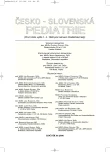-
Medical journals
- Career
Therapy of Diabetic Ketoacidosis
Authors: D. Csomor 1; T. Šagát 1; D. Karovič 3; Ľ. Barák 2; E. Jančová 2; J. Staník 2; M. Benedeková 2; H. Trimmel 3; P. Gašparec 1; R. Riedel 1
Authors‘ workplace: Detská klinika anestéziológie a intenzívnej medicíny pri Slovenskej zdravotníckej univerzite a Detskej ; fakultnej nemocnici s poliklinikou, Bratislava prednosta kliniky prof. MUDr. T. Šagát, CSc. I. detská klinika Lekárskej fakulty Univerzity Komenského a Detskej fakultnej nemocnice s poliklinikou 1; Bratislava prednostka kliniky doc. MUDr. M. Benedeková, PhD., mim. prof. 2; Oddelenie anestézie, intenzívnej a urgentnej medicíny, AKH Wiener Neustadt, Rakúsko vedúci oddelenia Dr. med. H. Trimmel 3
Published in: Čes-slov Pediat 2006; 61 (10): 603-609.
Category: Comprehensive Report
Overview
The cause of brain oedema in diabetic ketoacidosis in children has not been clarified yet. It has not been proved whether there is a iatrogenic damage induced by high doses of insulin, administration of bicarbonate or the large volume of hypotonic solution. Likewise, there is no evidence of hypoxic hypothesis on the basis of brain vasoconstriction in compensation of diabetic metabolic acidosis by hyperventilation with subsequent hypocapnia. It is therefore impossible to exclude idiosyncratic reaction of the organism, although it is difficult to expect also for the fact that the development of brain oedema most frequently occurs during the first manifestation of diabetes. Most authors agree that the risk of brain oedema development can be decreased by strict individualization of therapy with gradual adjustment of osmolality, which in the hypovolemic shock is preceded by volume resuscitation. In general it is recommended to decrease glycemia by ≤4–5 mmol/l/h, to adjust hyponatremia by 0.5–2 mmol/l/h (≤15–20 mmol/l/day) and to decrease osmolality by ≤30–40 mOsm/day (the risk decrease is by >3 mOsm/kg/h). The authors describe the therapeutic procedure in diabetic ketoacidosis, having been used at their workplace.
Key words:
diabetic ketoacidosis (DKA), children, brain oedema in diabetic ketoacidosis, procedure, therapy
Labels
Neonatology Paediatrics General practitioner for children and adolescents
Article was published inCzech-Slovak Pediatrics

2006 Issue 10-
All articles in this issue
- The Practical Significance of Non-cholesterol Sterols during Monitoring of Drug Treatment of Familial Hypercholesterolemia in Children and Adolescents
- Long-term Observation of Functional Structural Changes in Children with Vesicoureteric Reflux
- Function of Endocrine Glands in Patients with Anorexia Nervosa
- Familial Hypomagnesemia with Hypercalciuria and Nephrocalcinosis – Cases and Differential Diagnosis
- The First Case of Glucose Transporter Type 1 (GLUT-1) Deficiency Syndrome in Slovakia
- Tubulization of Transposed Stomach in Atresia of Esophagus
- Experience with the Enzyme Substitution Therapy in Mucopolysaccharidosis
- Diabetic Ketoacidosis
- Therapy of Diabetic Ketoacidosis
- Transplantation of Hematopoietic Cells in Children
- Rational Antibiotic Therapy in Neonatology
- Czech-Slovak Pediatrics
- Journal archive
- Current issue
- Online only
- About the journal
Most read in this issue- Diabetic Ketoacidosis
- The First Case of Glucose Transporter Type 1 (GLUT-1) Deficiency Syndrome in Slovakia
- Therapy of Diabetic Ketoacidosis
- Familial Hypomagnesemia with Hypercalciuria and Nephrocalcinosis – Cases and Differential Diagnosis
Login#ADS_BOTTOM_SCRIPTS#Forgotten passwordEnter the email address that you registered with. We will send you instructions on how to set a new password.
- Career

